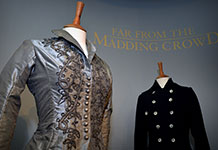
Costumes worn by Carey Mulligan in the new film adaptation of Far from the Madding Crowd - image: Jonathan North/Dorset County Museum © 2015
New online resource to explore fashion in Thomas Hardy's writing
The new film version of Thomas Hardy’s Far from the Madding Crowd feeds into the ongoing fascination for fashion depicted in classic novels and their modern adaptations for TV and film. A new online facility has been developed by the University of Exeter and Dorset County Museum to catalogue references to clothing in Hardy’s writing and the time in which he lived.
The costumes worn by the actress Carey Mulligan, who stars as Bathsheba Everdene in the latest Far From the Madding Crowd production, will be on display at the Dorset County Museum until the 8 June and will provide an exciting complement to the new online resource.
The ‘Thomas Hardy and Clothing’ project will highlight the importance of fashion in Hardy’s writing by providing references to clothing in his fiction, poetry, letters and biographies. It will also provide a greater understanding of the historical, social and political context in which Hardy wrote and lived.
Jonathan Godshaw Memel is a PhD student at the University of Exeter whose project, ‘Thomas Hardy and Education’, involves leading work on the prototype online resource alongside the University’s Hardy expert and Associate Professor of English, Angelique Richardson.
The significance of the project was explained by Professor Richardson. She said:”Dress is crucial in Hardy's fiction for indicating a character's profession, social and economic status or role, for bringing colour to local scenes, for expressing but often subverting custom and transgressing gender norms. Bathsheba flouts Victorian convention, not least dress code, by not riding side-saddle in the opening scenes of Far From the Madding Crowd, when she also allows her hat to fly off, in disregard for propriety: 'It went over the hedge, I think', she remarks. Clothing can also indicate moods, emotions and character. Bathsheba is often associated with the colour red, which signals her feistiness - she wears 'a rather dashing velvet dress, carefully put on before a glass'; on another occasion Hardy points out 'the red feather of her hat'. The database will show for the first time what such attire looked like and by whom it was worn.”
The project builds upon extensive research by Exeter students, who were instrumental in collating the references to clothing, later adding themes to the database.
Professor Richardson added:“As well as providing a useful resource to students, allowing them to connect their academic learning with historical objects, the online facility will raise a greater awareness of the significant archive and costume collections in the South West. Hardy enthusiasts from around the world will be able to view our research and add their thoughts.”
Memel’s enthusiasm for Hardy and the project is evident from the way in which the online resource developed. He said:“The widespread enthusiasm for Hardy's writing and its depictions of clothing is clear from the response to recent exhibitions at the Dorset County Museum. We have been able to produce an educational resource that truly reflects such engagement by working closely with the museum’s curators and volunteers, enabling members of the public, researchers and students to learn more about Hardy’s life and work in and around Dorset, an area of outstanding natural beauty in the South West of England.”
Humanities - Thomas Hardy and Clothing Blog
Date: 11 May 2015
